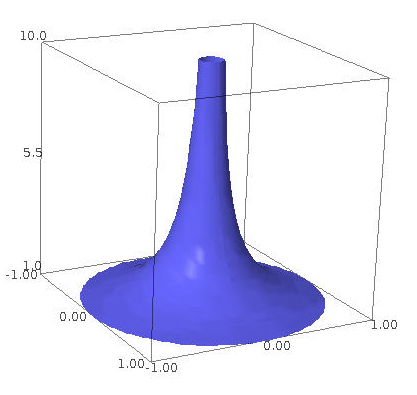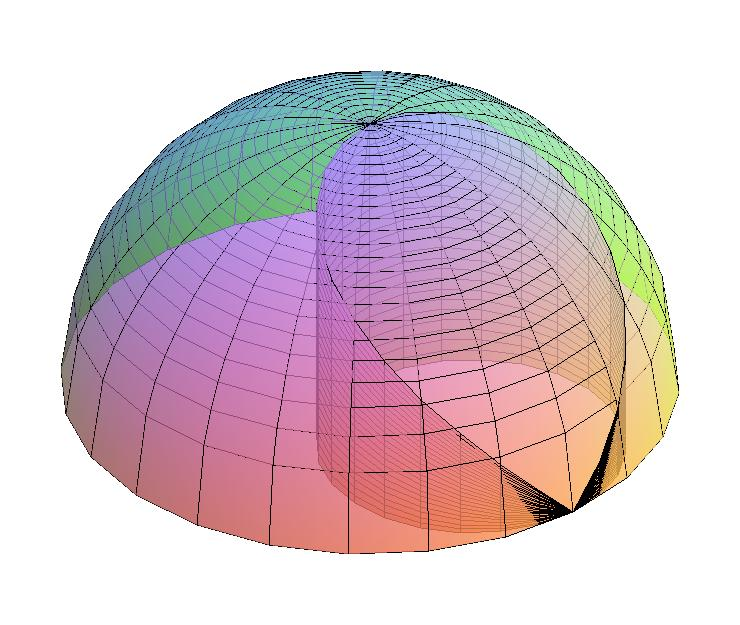Evaluate The Cylindrical Coordinate Integral
Suppose nosotros take a surface given in cylindrical coordinates equally $z=f(r,\theta)$ and we wish to find the integral over some region. We could attempt to translate into rectangular coordinates and do the integration at that place, only it is frequently easier to stay in cylindrical coordinates.
How might we approximate the volume nether such a surface in a way that uses cylindrical coordinates directly? The bones idea is the same as before: we split up the region into many small regions, multiply the surface area of each small region by the height of the surface somewhere in that niggling region, and add them upwards. What changes is the shape of the small regions; in order to have a nice representation in terms of $r$ and $\theta$, we use small pieces of ring-shaped areas, as shown in figure 15.2.i. Each small region is roughly rectangular, except that 2 sides are segments of a circle and the other two sides are not quite parallel. Near a bespeak $(r,\theta)$, the length of either circular arc is about $r\Delta\theta$ and the length of each straight side is simply $\Delta r$. When $\Delta r$ and $\Delta \theta$ are very small-scale, the region is nearly a rectangle with area $r\Delta r\Delta\theta$, and the volume under the surface is approximately $$\sum\sum f(r_i,\theta_j)r_i\Delta r\Delta\theta.$$ In the limit, this turns into a double integral $$\int_{\theta_0}^{\theta_1}\int_{r_0}^{r_1} f(r,\theta)r\,dr\,d\theta.$$
Effigy fifteen.2.1. A cylindrical coordinates "filigree''.
Instance 15.2.1 Find the volume under $z=\sqrt{4-r^2}$ in a higher place the quarter circle bounded by the two axes and the circle $10^ii+y^2=four$ in the first quadrant.
In terms of $r$ and $\theta$, this region is described past the restrictions $0\le r\le 2$ and $0\le\theta\le\pi/two$, and then we have $$\eqalign{ \int_{0}^{\pi/2}\int_{0}^{2} \sqrt{four-r^ii}\;r\,dr\,d\theta &=\int_{0}^{\pi/two}\left. -{1\over3}(4-r^2)^{3/two}\right|_0^ii\,d\theta\cr &=\int_{0}^{\pi/2} {8\over3}\,d\theta\cr &={4\pi\over3}.\cr }$$ The surface is a portion of the sphere of radius two centered at the origin, in fact exactly one-eighth of the sphere. We know the formula for book of a sphere is $(four/3)\pi r^iii$, so the volume nosotros have computed is $(ane/8)(iv/3)\pi 2^3=(4/3)\pi$, in understanding with our respond. (From some other point of view, what we've done is prove that the volume of a sphere of radius 2 is $(32/3)$. If you replace 2 by $a$ and exercise the integral again, information technology is non whatever more difficult, and you lot will testify that the volume of a sphere of radius $a$ is $(four/3)\pi a^three$.) $\square$
This example is much like a simple one in rectangular coordinates: the region of involvement may be described exactly by a constant range for each of the variables. Equally with rectangular coordinates, nosotros tin accommodate the method to deal with more complicated regions.
Example 15.ii.two Detect the book under $z=\sqrt{4-r^two}$ higher up the region enclosed by the bend $r=2\cos\theta$, $-\pi/2\le\theta\le\pi/2$; run into figure 15.ii.2. The region is described in polar coordinates past the inequalities $-\pi/2\le\theta\le\pi/2$ and $0\le r\le2\cos\theta$, and so the double integral is $$ \int_{-\pi/2}^{\pi/two}\int_{0}^{2\cos\theta} \sqrt{4-r^2}\;r\,dr\,d\theta =two\int_{0}^{\pi/two}\int_{0}^{ii\cos\theta} \sqrt{4-r^2}\;r\,dr\,d\theta. $$ Nosotros can rewrite the integral every bit shown considering of the symmetry of the volume; this avoids a complication during the evaluation. Proceeding: $$\eqalign{ 2\int_{0}^{\pi/two}\int_{0}^{2\cos\theta} \sqrt{4-r^two}\;r\,dr\,d\theta &=2\int_{0}^{\pi/2}-{i\over3}\left.(4-r^2)^{iii/2}\right|_0^{2\cos\theta}\,d\theta\cr &=2\int_{0}^{\pi/2}-{8\over3}\sin^three\theta+{8\over3}\,d\theta\cr &=\left.2\left(-{8\over3}{\cos^3\theta\over3}-\cos\theta+{8\over3}\theta\correct)\right|_0^{\pi/two}\cr &={8\over3}\pi-{32\over9}.\cr }$$ $\square$
| |
Figure 15.2.2. Book over a region with non-constant limits.
Yous might have learned a formula for calculating areas in polar coordinates. It is possible to compute areas equally volumes, and then that y'all need only remember one technique. Consider the surface $z=i$, a horizontal plane. The volume under this surface and above a region in the $10$-$y$ aeroplane is simply $i\cdot(\hbox{area of the region})$, and then computing the volume really but computes the surface area of the region.
Example 15.ii.3 Find the surface area exterior the circle $r=2$ and within $r=iv\sin\theta$; come across figure fifteen.two.3. The region is described by $\pi/6\le\theta\le5\pi/6$ and $2\le r\le4\sin\theta$, then the integral is $$\eqalign{ \int_{\pi/six}^{five\pi/6}\int_2^{4\sin\theta}1\,r\,dr\,d\theta &=\int_{\pi/6}^{v\pi/half-dozen}\left. {1\over2}r^2\right|_2^{four\sin\theta}\,d\theta\cr &=\int_{\pi/six}^{5\pi/6}8\sin^2\theta-2\,d\theta\cr &={4\over3}\pi+2\sqrt3.\cr }$$ $\square$
Figure 15.2.3. Finding area past computing book.
Exercises xv.2
Doing integrals in cylindrical coordinates is no different than any other integral.
Ex 15.2.i Discover the volume in a higher place the $ten$-$y$ aeroplane, under the surface $r^ii=2z$, and inside $r=ii$. (answer)
Ex 15.2.ii Find the volume inside both $r=1$ and $r^2+z^two=4$. (answer)
Ex 15.2.3 Observe the book below $z=\sqrt{one-r^2}$ and above the top one-half of the cone $z=r$. (answer)
Ex xv.2.4 Find the book below $z=r$, above the $x$-$y$ airplane, and inside $r=\cos\theta$. (answer)
Ex 15.2.five Find the volume below $z=r$, above the $x$-$y$ airplane, and inside $r=one+\cos\theta$. (answer)
Ex xv.ii.6 Find the volume between $x^2+y^two=z^2$ and $x^ii+y^2=z$. (answer)
Ex fifteen.2.7 Find the area inside $r=1+\sin\theta$ and outside $r=two\sin\theta$. (respond)
Ex xv.2.8 Find the surface area within both $r=2\sin\theta$ and $r=2\cos\theta$. (respond)
Ex 15.2.9 Detect the area inside the four-foliage rose $r=\cos(2\theta)$ and outside $r=1/2$. (answer)
Ex 15.2.10 Find the area inside the cardioid $r=2(1+\cos\theta)$ and exterior $r=2$. (answer)
Ex xv.ii.11 Find the area of ane loop of the three-leaf rose $r=\cos(3\theta)$. (answer)
Ex 15.two.12 Compute $\ds \int_{-iii}^iii\int_0^{\sqrt{nine-ten^2}} \sin(x^2+y^2)\,dy\,dx$ by converting to cylindrical coordinates. (answer)
Ex 15.two.thirteen Compute $\ds \int_{0}^a\int_{-\sqrt{a^two-ten^ii}}^0 10^2y\,dy\,dx$ past converting to cylindrical coordinates. (answer)
Ex fifteen.2.14 Find the book under $z=y^2+ten+two$ in a higher place the region $ten^2+y^2\le 4$ (answer)
Ex 15.two.15 Observe the book between $z=ten^2y^3$ and $z=1$ above the region $ten^two+y^2\le 1$ (respond)
Ex 15.ii.xvi Find the volume inside $ten^two+y^2=1$ and $x^2+z^2=1$. (answer)
Ex 15.2.17 Find the volume nether $z=r$ above $r=3+\cos\theta$. (respond)
Ex 15.2.18 Figure xv.ii.4 shows the plot of $r=1+iv\sin(5\theta)$.
Figure 15.2.iv. $r=1+4\sin(5\theta)$
a. Describe the behavior of the graph in terms of the given equation. Specifically, explain maximum and minimum values, number of leaves, and the `leaves within leaves'.
b. Give an integral or integrals to make up one's mind the area outside a smaller leaf just within a larger foliage.
c. How would irresolute the value of $a$ in the equation $r=one+a\cos(5\theta)$ modify the relative sizes of the inner and outer leaves? Focus on values $a\geq 1$. (Hint: How would we alter the maximum and minimum values?)
Ex 15.two.xix Consider the integral $\ds\dint{D} {1\over\sqrt{x^ii+y^2}} \; dA$, where $D$ is the unit deejay centered at the origin. (This is the same shape described in a unlike manner in do thirteen in section 9.7.)

a. Why might this integral be considered improper?
b. Calculate the value of the integral of the same function $\ds 1/\sqrt{x^2+y^two}$ over the annulus with outer radius 1 and inner radius $\delta$.
c. Obtain a value for the integral on the whole disk by letting $\delta$ approach 0. (answer)
d. For which values $\lambda$ can we replace the denominator with $(x^two+y^2)^\lambda$ in the original integral and still go a finite value for the improper integral?
Evaluate The Cylindrical Coordinate Integral,
Source: https://www.whitman.edu/mathematics/calculus_online/section15.02.html
Posted by: conwayfixects.blogspot.com



0 Response to "Evaluate The Cylindrical Coordinate Integral"
Post a Comment